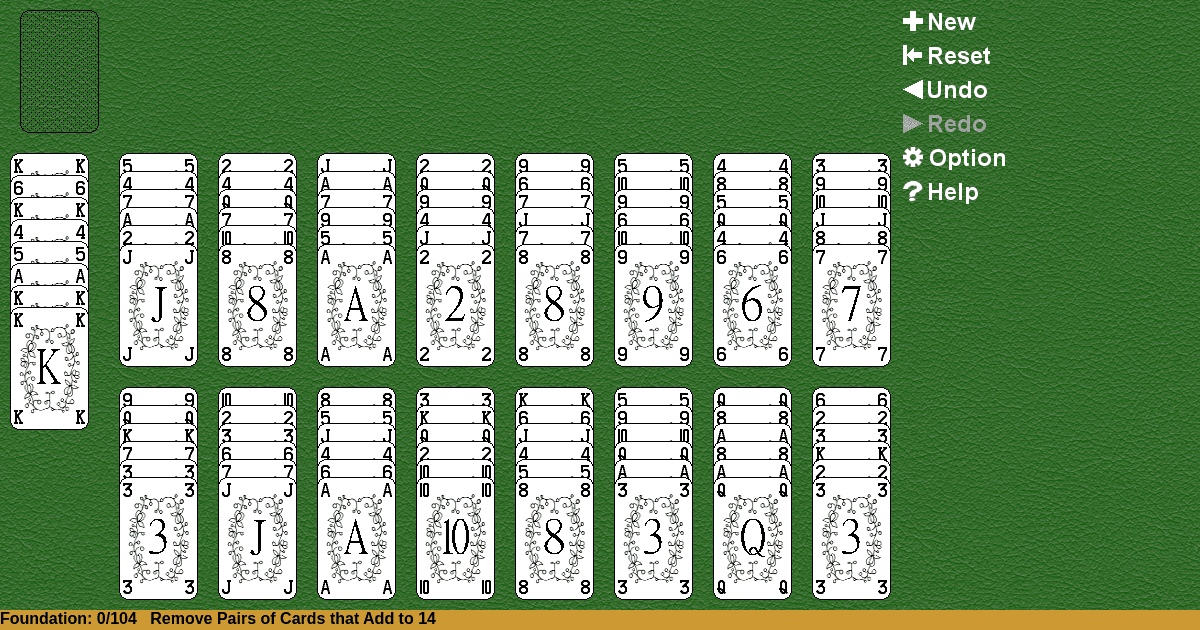Juvenile
Home |
How to play |
FAQ |
About
How to play Juvenile?
Game Objective:
The primary goal in Juvenile Solitaire is to discard all cards from play by pairing cards whose combined ranks total exactly fourteen. Only specific pairs are valid, and the game is won when no cards remain.
Setup & Layout:
Deck: Juvenile Solitaire is played with a standard 52-card deck. Some digital implementations use two decks (104 cards), but the classic version uses one deck unless otherwise specified.
Tableau: Deal eight piles (tableau piles) with eight cards each, for a total of 64 cards. All cards in the tableau are dealt face up and are fully visible.
Reserve (if used): Some variants include a reserve pile with the remaining cards (if a double deck is used, or if not all cards fit in the tableau). In single-deck play, there are no reserve or stock cards.
Waste/Discard Pile: There is a waste pile where discarded pairs are placed. This pile is not used for play; it simply holds removed cards.
Key Play Areas:
- Tableau: The main play area with eight piles of face-up cards.
- Waste/Discard Pile: Holds pairs removed from play.
Juvenile Solitaire Rules:
Pairing Principle: Only pairs of cards whose ranks add up to exactly fourteen may be discarded together. The valid pairs are:
- King (13) + Ace (1)
- Queen (12) + 2
- Jack (11) + 3
- 10 + 4
- 9 + 5
- 8 + 6
- 7 + 7 (two sevens may be paired together)
Card Movement:
- No building is permitted on tableau piles; cards cannot be moved between tableau piles.
- Only the top card of each tableau pile is available for pairing and removal.
Pair Removal:
- To remove a pair, both cards must be the topmost cards of any two tableau piles.
- Once paired, the two cards are placed in the waste/discard pile and are out of play.
Gameplay:
Player Turn:
- Examine the top card of each tableau pile.
- Identify any two top cards whose ranks sum to fourteen.
- Remove valid pairs and place them in the waste pile.
- After removing a pair, the next card in each affected tableau pile becomes available for play.
No Moves Available:
- If no valid pairs remain among the top cards of the tableau, the game ends.
Stock/Reserve Usage:
- In the standard single-deck version, there is no stock or reserve; all cards are dealt at the start.
- If a reserve is used (in some variants), cards from the reserve are turned face up and added to the tableau piles as spaces become available.
Winning & Losing Conditions:
Winning: The game is won when all cards are successfully discarded in valid pairs totaling fourteen, leaving no cards in the tableau.
Losing: The game is lost (unwinnable) if no valid pairs remain among the top cards of the tableau, and cards are still present in the tableau.
Special Rules & Edge Cases:
Empty Tableau Piles:
- In standard play, empty tableau piles remain empty; no cards may be moved to fill them.
- If a reserve is used, a new card from the reserve may be dealt to fill an empty tableau pile.
Pairing Two Sevens:
- The only valid pair of identical ranks is two sevens, which may be paired and discarded together.
No Redeal:
- Once all cards are dealt, there is no redeal. The player must work only with the available top cards.
No Building or Sequence Formation:
- Cards cannot be built in sequence, moved between piles, or rearranged in any way. Only pairing and removal are allowed.
Card Availability:
- Only the top card of each tableau pile is ever available for pairing. Cards beneath are inaccessible until the top card is removed.
Summary of Key Terms:
- Tableau: The primary area of play, consisting of eight piles of face-up cards.
- Waste/Discard Pile: The area where discarded pairs are placed.
- Pairing: The act of removing two cards whose ranks sum to fourteen.
These rules define the unique gameplay of Juvenile Solitaire and differentiate it from other solitaire variants.




























































